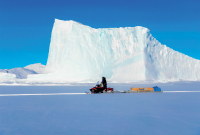Support strong Canadian climate journalism for 2025
Inuit-led conservation received a boost on Wednesday, with the federal government announcing about $3 million in funding for programs in Nunatsiavut, an area along the coast of Labrador with an Inuit regional government, part of which will fund data collection efforts on how climate change is affecting the land, water and sea ice.
The impacts of climate change are already felt deeply by Labrador Inuit, said Johannes Lampe, president of Nunatsiavut, who noted the funding will help protect natural resources while allowing participants “to keep their bond with the land that has sustained us since time immemorial.”
Inuit Nunangat — which includes the Inuvialuit Settlement Region in the northern Northwest Territories, Nunavut, Nunavik in northern Quebec and Nunatsiavut in Newfoundland and Labrador — is warming four times faster than the global average. That increased warming translates to changes in sea ice, melting permafrost, more extreme weather events and more. All of the changes harm Inuit ways of life and lead to the loss of traditional knowledge and land.
Indigenous Peoples across the world contribute the least planet-warming greenhouse gas emissions. Meanwhile, 80 per cent of the world’s biodiversity is on Indigenous lands, despite Indigenous Peoples only making up five per cent of the global population, according to the United Nations.
“Certainly, we are not just hunting and fishing and gathering. We are watching the land, the climate,” said Lampe in a media availability.
“For me, the North is a filter. It gathers all of the pollution that is happening around the world. And so, when that filter is clogged, the health and well-being of Labrador Inuit is impacted.”
The funding touches on four initiatives, explained Environment and Climate Change Minister Steven Guilbeault. The department’s Indigenous Guardians Fund, a program that funds monitoring and protection of land and water by Indigenous people on their traditional territories, will contribute $1.8 million. Monitoring of the land, water and sea ice will inform how land is conserved in the future.
“Labrador Inuit have a deep and profound relationship with the natural environment of Nunatsiavut and have been stewards of the land for millennia,” said Guilbeault.
“By trusting and respecting Indigenous traditional roles, knowledge, and science, we walk the path of reconciliation while working toward Canada’s conservation goals. Guardian programs are crucial in these efforts, as they help to protect ecosystems, species, and cultural heritage.”
More than $200,000 was put forward from Parks Canada’s Guardians Access program, which specifically “provides Nunatsiavut Inuit beneficiaries opportunities to spend time in Torngat Mountains National Park, stay at the Torngat Mountains Basecamp and Research Station, and connect with the land and people.”
There was also more than $700,000 put forward from Crown-Indigenous Relations and Northern Affairs Canada’s Climate Change Preparedness in the North program to support sea ice research and the creation of hazard maps to make sea ice travel safer. Another $300,000 or so will go towards studying “the sustainability of hunting wild food in light of changing environmental conditions, such as snowfall and vegetation.”
Environment and Climate Change Canada has put forward about $60 million for more than 170 First Nations, Inuit and Métis Guardians initiatives since 2018.
This article has been updated to include all regions of Inuit Nunangat.






Comments